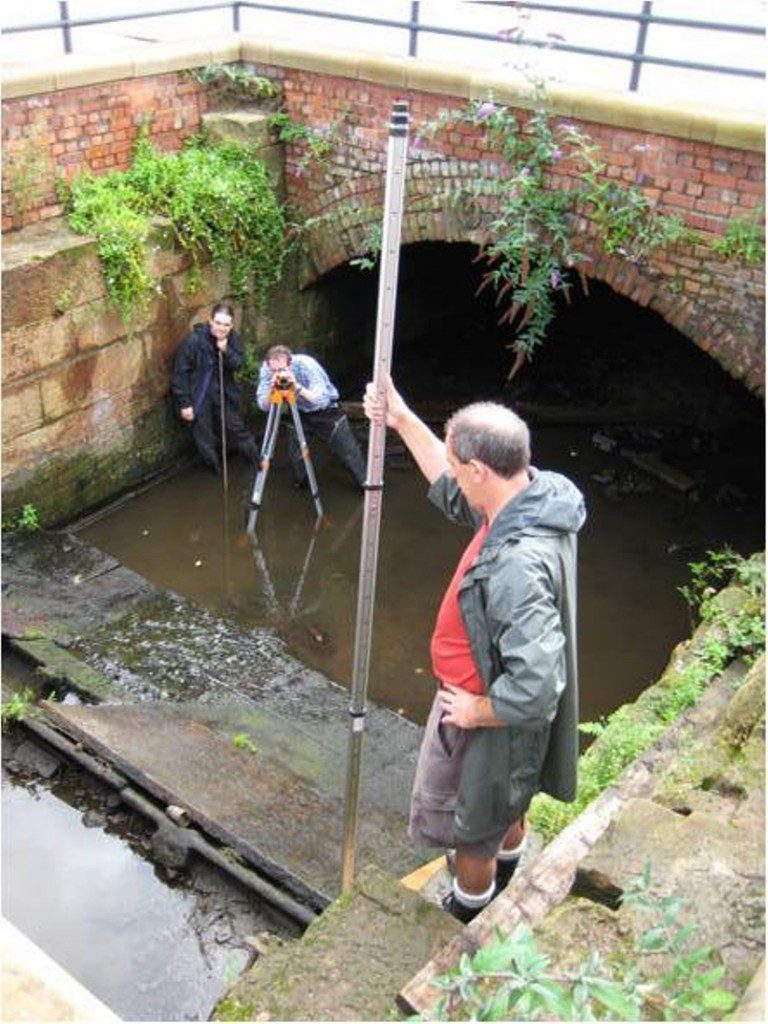Originally posted on 26 November 2009
I first encountered Sheffield Renewables at the Green Fair in June 2009. I jumped at the chance to get involved because I’ve been interested in water power for as long as I can remember. I like hands on activities, so I was attracted to the Kelham Island workdays. The aim was to determine the height through which the water drops at the location where the old water wheel was (and the new one should be installed). This is known as the ‘head height’. Head height is important because it is directly proportional to the amount of energy that a new water wheel would generate. Measuring this height turns out to be more complicated than it sounds. Not least because it is important to measure the height while the goit is in full flow.
The word “goit” means “a human made channel for carrying water either to or from a hydro power site”. It is a dialect word, not heard much outside Yorkshire and Derbyshire. Alternative terms include leat, fleam, race, or the Standard English “conduit”. At Kelham Island the head goit takes water from the weir on the River Don, past Kelham Island Musem to the wheel pit, while the tail goit takes the water away from the wheel pit, under the new dual carriage way on Corporation Street, past the modern flats at Millsands and back to the River Don.
I didn’t understand the need for surveying the levels along the goit before I got involved in the workdays. It seemed that surely if the infrastructure survives and there has been a wheel in the past, any water wheel put there now would work just as well. However, I soon found out that there have been some changes to the goit in recent years. The head goit has gradually silted up and in some areas there are trees and other plants growing where water would have flowed. Also the inlet from the River Don into the head goit is now only a third of the width it used to be. The tail goit is similarly affected by silting up and vegetation growth. At Corporation Street, further investigation is needed to find out how the concrete road strengthening for the dual carriageway improvements have affected the flow of water under the bridge.

To begin to determine the effects of all of these developments, we used a theodolite at the workdays to asses the water level at various points along the goit. A theodolite is a telescope on a tripod that can be made perfectly level, with markings on the lens to read the height from a 4m ruler held by a person standing some distance away. Working along the length of the goit, the heights from the ruler are noted down and Richard and Abigail do the maths to show the crucial relationships between the levels of the weir, goit and wheel pit. In turn these enable the height that the water drops at the wheel pit and the size of the water wheel that can be used to be determined.
Personally, I am determined to help the project succeed in whatever way I can. There should be plenty of hands on opportunities to volunteer with me, such as shovelling silt out of the way of the water flowing between the River Don and the wheel pit. This will be followed by testing the goit to find out how much water can flow through it. If you are interested in getting involved in these activities, make sure you have signed up for the bimonthly newsletter, keep an eye on our events calendar and email info@sheffieldrenewables.org.uk to let us know.
There are also opportunities to volunteer in other aspects of Sheffield Renewables’ work. To find out that voluntary roles most urgently need filling, check out the Get Involved section of our website. If you don’t see anything you fancy, you can always email info@sheffieldrenewables.org.uk to find out if there is a team you could join that covers the tasks you would like to undertake.
By Rowan Watson Taylor
